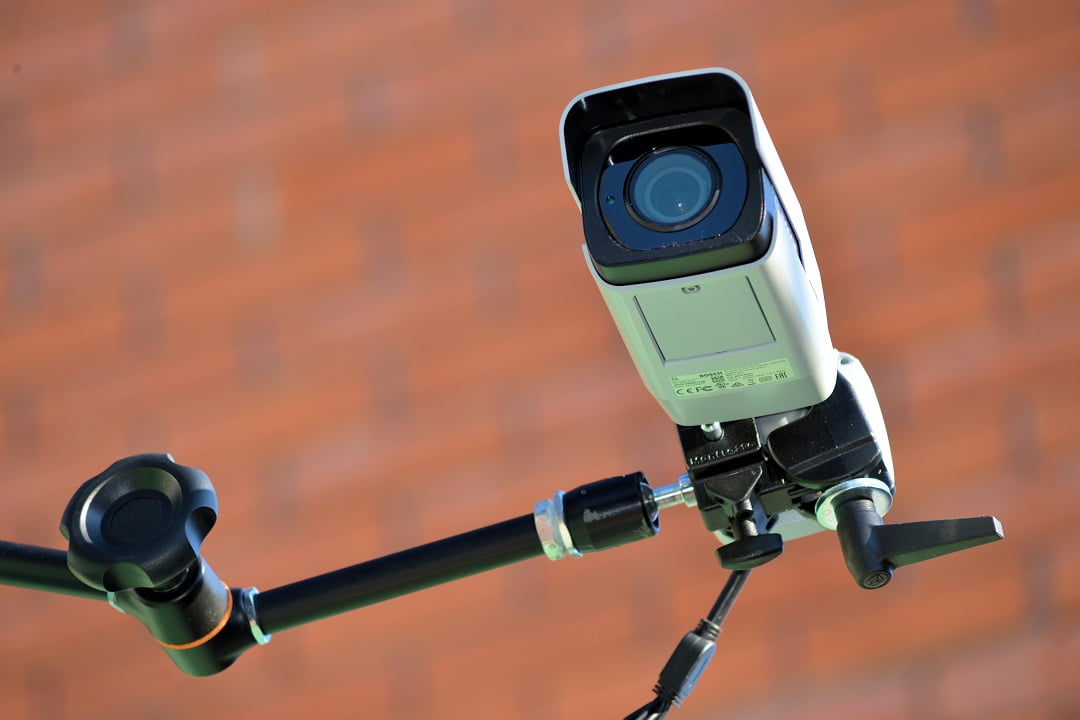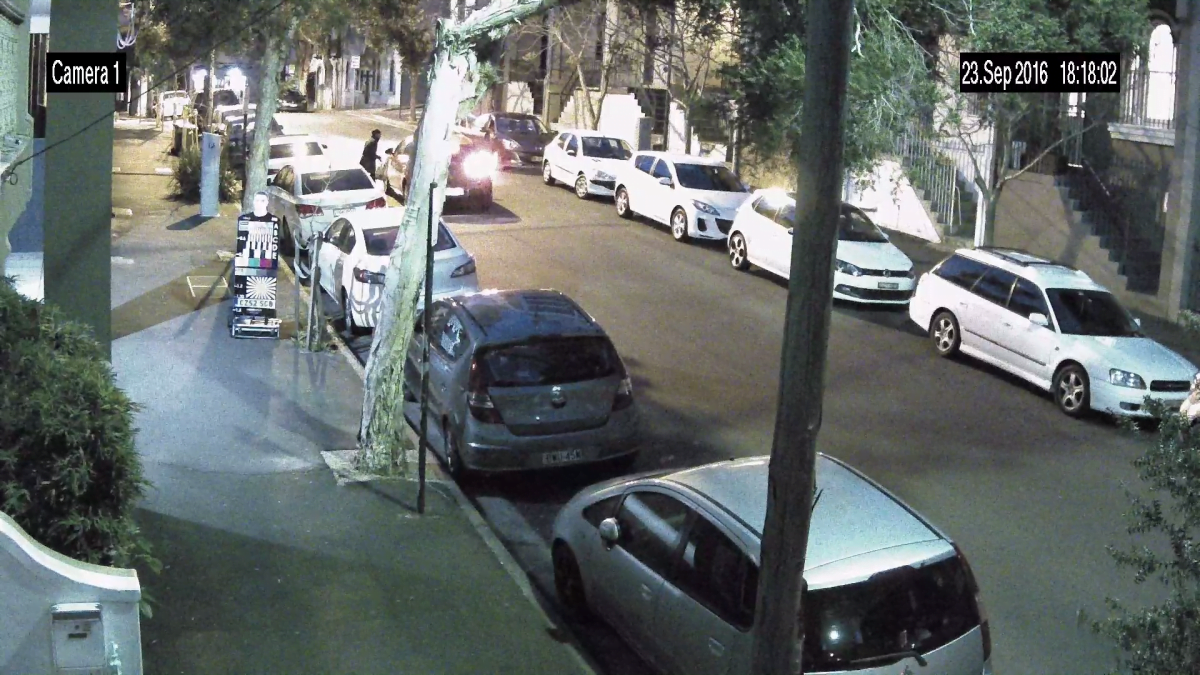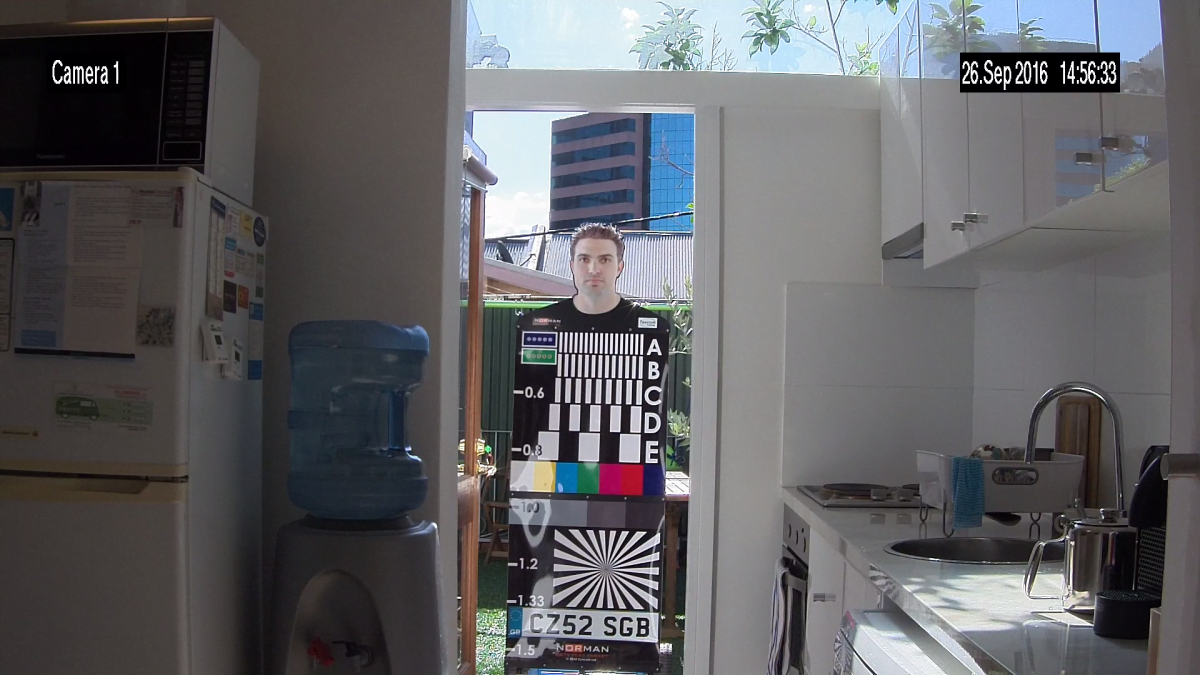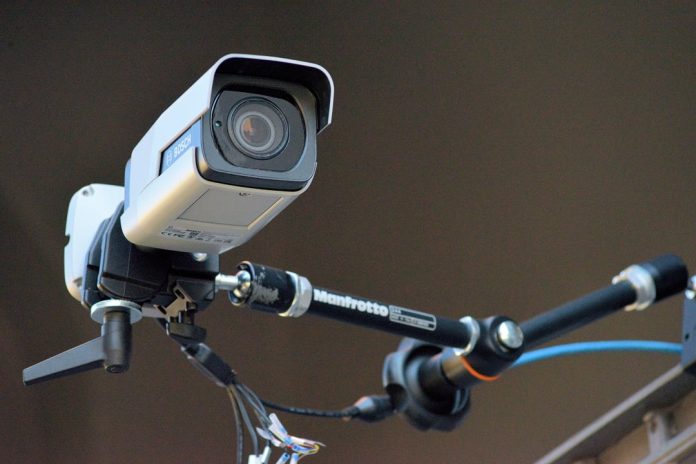I WASN’T sure what to think of the Bosch IP 5000 when I unpacked it – the sunshade and the overall camera are quite light but when it’s up and running you find that this a surprisingly good camera in the best tradition of motorised, remote autofocus bullet cameras.
BOSCH’S IP 5000 day/night bullet camera is an IP66-rated 5MP bullet camera with a motorised, varifocal, IR-corrected, board-mounted 2.7-12mm F1.4 lens offering 32-100 degrees of viewing angle and 18-53 degrees of vertical angle. The motorized zoom lens has automatic focus adjustment with 1:1-pixel mapping to ensure the camera is always accurately focused. It works extremely well in the field.
The camera has a 30m IR array comprising of 4 850nm LEDs. The sensor is a 1/2.9-inch CMOS and is claimed to offer minimum scene illuminations of 0.07 lux in colour, 0.05 lux in monochrome and 0 lux with IR activated. At sensible shutter speeds only the last figure is accurate and monochrome performance is considerably better than the .02 difference suggested when compared to colour in marginal light. Dynamic range is 76dB – that’s a modest number that belies the cameras true WDR capability. It does rather well in strong backlight.
This camera is nicely made and ships with all the relevant flying leads for PoE, DC, audio in and out, etc. It has a microSDXC card slot (2TB capacity) for local recording. There’s an alarm input and output, audio input and output, with G.711 audio compression in duplex. Power is PoE, 24 V AC or +12 V DC SELV class 2 and consumption is around 12 W from all sources. There’s also Auto-MDIX for straight or crossed network cabling.

Other features include intelligent Dynamic Noise Reduction to limit bandwidth and storage requirements, and H.264 compression technology, which Bosch says is 50 per cent more efficient than many competitors. There’s area-based encoding, bitrate optimised profile, multiple streams, RoI and remote ePTZ, 2-way audio and audio alarm, tamper and motion detections, storage management through Bosch Video Recording Manager. An analogue video output enables the camera to operate in hybrid mode. This mode provides simultaneous high resolution HD video streaming and an analogue video output via an SMB connector.
The IP 5000 supports time-based or alarm-based JPEG posting to 4 different accounts. These accounts can address FTP servers or cloud-based storage facilities like Dropbox. Video clips or JPEG images can also be exported to these accounts. Alarms can be set up to trigger an e-mail or SMS notification. Password protection has 3 levels and 802.1x authentication is supported. To secure Web browser access, you set up HTTPS using an SSL certificate stored in the camera.

The camera conforms to the ONVIF Profile S specification and supports Bosch Content Based Imaging Technology and Dynamic Transcoding. You can drive the camera using Bosch’s Video Security app for iOS or Android devices, or using Video Security Client software. The Bosch video security mobile App has been developed to enable access to live HD surveillance images anywhere users are connected. The app gives complete control of cameras – in this case zoom and focus functions, and users can also tweak dynamic transcoding features to playback images over low-bandwidth connections.
Video analysis configurations include Silent VCA, Profile1/2, Scheduled and Event-triggered. There’s tamper detection, 9 default scene modes, 8 privacy zones, video authentication off, watermark, MD5, SHA-1, SHA-256, and display stamping of name, logo and time. Mechanically, there’s 3-axis adjustment pan of 360 degrees, tilt of 90 degrees and rotation of 360 degrees. Dimensions are 271mm(H) x 90mm (W) x 90mm (D). Weight is 1.3kg and operating temperature range is strong at -30 to 60C. The camera has loads of other integrated features and capabilities, as well as comprehensive support from proprietary and third party software.
Test driving the Bosch IP 5000
We are running this camera with a NetGear ProSafe GS108P PoE switch on our dedicated Dell Optiplex 9020 i7 server via the Bosch camera browser. There’s nothing else on the network at the moment. As soon as I power up I hop in and run through settings one at a time. Generally, I’ll just get WDR activated and see what I think of brightness, check the shutter defaults are at 1/30th of a second and take a look at auto white balance, selecting low pressure sodium if available, as it is here.
Picture settings include contrast, saturation, brightness, white balance in 4 automatic modes and manual mode, Day/Night settings, colour and monochrome settings, automatic electronic shutter and selections, adjustable IR. Video functions allow twiddling with sharpness, backlight compensation, contrast enhancement, Bosch Intelligent Dynamic Noise Reduction with separate temporal and spatial adjustments. There’s also intelligent defog. I leave a lot of this at default or select auto settings.

With the camera hanging off the front verandah, I sit down at the monitor and set up my view. Wow – this F1.4 varifocal 2.7-12mm lens supported by the camera browser has the fastest zoom and refocus I’ve met – really, it’s barnstormingly fast. Pull the slider and refocus is right behind you – less than half a second behind – that’s exceptionally useful for real time operations. With other cameras you are often waiting tens of seconds for auto focus functions to take place after moving focal length.

It’s just before midday and there’s strong light and deep shade out front. Notwithstanding some variable overexposure on the sunny side of the street with WDR on auto in 70,000 lux, the 5000 Bullet offers a strong and composite image at all times. I like a bit less overexposure on the bright side but the price is worth paying – I turn the WDR function on and off a few times to make sure of my choice. Yep – it’s better having it on. Next, I wind the lens in to about 6.5mm.



Depth of field at 5mm is sensational and noise levels are very low in this good light and later in bad light – this is not as common a quality as you’d think. Until light levels really start to drop, I can see noise only if I really look for it. Chromatic aberrations are very low at 5mm though more pronounced at 2.7mm. Motion blur is low – I can get plates at 20kmph easily in good light – faces are a snap. Fiddling with settings is very easy via the browser. Colour rendition is very pleasing – the blues and reds really pop.

As the afternoon wears on, I take the camera out back. It’s early spring but light levels are over 75,000 lux in direct sun. I leave focal length at the same 6.42mm I was using out front. It’s longer than standard but there really isn’t much point making a change in a narrow street scene like this. Messing with the lens wizard, I notice immediately that there’s some barrel distortion at the wider end – it’s mostly gone at 5mm – past which point it gives way to very mild moustache distortion I can still see in the block wall at 6.42mm.
Generally, WDR performance is tight, just as it was out front. In the lane I find again that although I get more distant detail of bright sky and tree branches at 100m with backlight compensation off, I lose fine detail in brickwork closer in. After some fiddling, I leave BLC on. It makes the most sense at this focal length.

Switching from full wide to full tele is just so easy with this camera – that slider zoom and focus team is just brilliant. Full tele is 11mm which is really strong in my 70m lane application if I want to reach deeper into scenes. I get great faces and plates and I’ve lost all visible distortion and chromatic aberration long before I hit a focal length of 11mm. Colour and WDR is good when long, too. I go in and out quite a lot with this camera because it’s such a fast and easy process.

Image quality remains excellent in falling light. Around 4pm the light softens and as usual this brings out more detail in my scene and increases depth of field. As the light fades, the quality of the detail in brickwork and besser blocks is outstanding at 12m. I can’t help being very interested in the performance of this camera as night falls. At 5.27pm light is 7.3EV in lane – streetlights are on – the image still looks good. Noise is now creeping in – shutter speed has dropped – there’s a person fossicking in the rubbish up the lane and movements look a little ghostly. It’s 5.59pm and .05EV (around 4 lux) in the lane – things are getting yellow with auto WDR on and sodium lamp settings on but the 5000 remains in colour. Looks like we’ll have to push into monochrome. Still very high levels of detail and very low noise.

Now we are in night mode with IR activated. IR performance is very strong – the best I’ve had in the lane and I wish the street was darker so I could see how good it really is. I suspect it would give me the full 30m, which is not the normal state of affairs. The solid IR performance has support from great depth of field in monochrome all the way up towards 70 metres. There’s now some blooming around streetlights but image is very useful. Looking at traffic and walking people, shutter speed is 1/30th sec and I see some blur, so think I’ll see a little more of this out the front with faster moving traffic. The IP 5000 is also very good with IR off – depth of field remains strong.

IR performance internally is solid, too. The 5000’s proper IR array has no trouble illuminating internal spaces. There’s good contrast giving excellent sharpness, too. That’s very nice for those small details that more completely tell a story. Is the 5000 Bullet hands-down the best camera we have ever reviewed? With half our test completed, it’s right up there with the leaders.

Out front the next day I benefit from sharpness, contrast, colour rendition, very good depth of field. Things like plates and faces are spot on in good light – that’s not always the case. It’s a grey day today but I notice the tendency to over exposure on the bright side of the street. At around 4pm I can no longer get moving plates and there’s a little tone mapping surrounding cars and motorcycles as the camera system works to build the best images.

An hour later, performance is about the same – it’s been that kind of gloomy bright afternoon. At 5pm I still have excellent faces past 12m but plates and bodies of cars are getting ghostly and this continues in linear fashion as light falls. I decide to increase shutter speed to see if I can regain plates. At 6pm I up the shutter speed to 1/500th of a second. I lose a couple of stops of 2 of light but now have court admissible faces again – even at 20m they would convince a courtroom. I have more detail of the moving traffic but no readable plates. What about night performance out front?




Night time performance in 7 lux in colour shows good depth of field but I have some noticeable noise alongside the effects of a slow shutter speed – a little blooming and some blur. The slow shutter speed means some over exposure where headlights fall and I notice that at 16m in the Yaffa floodlights Norman is over exposed, though I have good contrast and a very readable plate. I have Norman from the C Line at 20m and enough contrast to recognise a known person quite readily.

When I put Ronnie Rotakin out the front I estimate about 25 degrees of blur, which is very good. Norman’s faces have sufficient contrast to be seen and a pedestrian walking past allows me to confirm that within 12m, I still have court admissible face recognition. I push to night mode and activate IR and all that noise is gone and the image looks lovely and composite. Monochrome – it’s so easy to underrate it. I have face recognition to 16m with more detail than before. This is very court admissible. I have no moving plates. Flare is denying me plate ID directly in front of the array but oblique angles give more detail.


Next day I find WDR performance looking from a typical internal space to 78,000 lux is variable. With the camera 14m from the backdoor, there’s a lot of blooming around Norman’s head but the internal spaces are well rendered, though perhaps a little darkly. There are CAs around light fittings at the widest focal length. I mess around with the ALC and scene modes trying to get the best performance and wind up using outdoor settings as I get closer to the door – there’s too much blooming otherwise. My settings from here on make the internal spaces darker than they would be otherwise, but still very useable. With the camera about 7.5m from the door, WDR performance is strong. It’s not the prettiest image – there’s some noise – but its court admissible with decent sharpness and the colour rendition is reasonably good, too.

At this point I go full tele at 7.5m from the target and this is the best image of Norman I get in the doorway – I have good visibility behind him as well. CAs are now gone and sharpness, colour rendition and low noise are noteworthy. I like long focal lengths for face recognition. When I bring the camera to the kitchen door it’s exposed to the full sun and starts introducing some digital work to the image stream. The foreground is darker as the camera works to handle the blazing sun outside. For operational facial ID in entry ways, it’s still great performance. Pulling the camera into the kitchen makes the foreground a couple of F stops darker but there’s no real difference otherwise. It’s solid facial ID. 
Finally, I take a look at the World Tower at 1000m with strong sidelight and an upwards tilt on the magic arm. There’s a little veiling flare and some noise as the camera does battle with all those photons but it’s good at widest angles of view, better at a focal length of about 6.6mm and best at full tele, with no CAs on powerlines of tree branches, strong sharpness, good colour rendition and very low noise.


Taken as a whole, this is a fine camera. Like many IR supported cameras there’s a point in its unassisted low light performance where blur and noise intrude but in typical street scenes it acquits itself very well, offering face recognition at 7 lux in colour inside 12m and stretching this to 16m in night mode. IR performance is strong. Other strengths of this camera include excellent depth of field, good colour rendition, particularly during the day, and a brilliant remote zoom and focus mechanism – by far the best we’ve experienced. WDR performance is good, too, especially with focal lengths from 6.5-11mm. ♦
By John Adams











